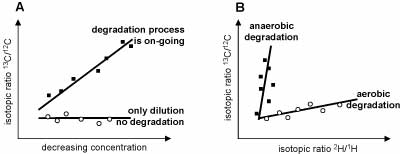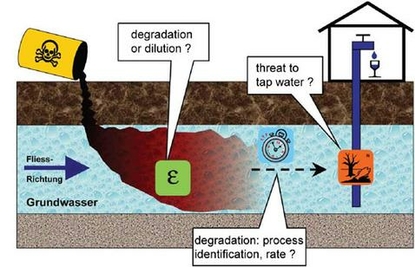Department Water Resources and Drinking Water
Contaminant Hydrology
The research group Contaminant Hydrology tackles water quality issues relevant for human health and ecology. We conduct basic and applied research with the goal to contribute to a sustainable water management and to be able to cope with present and future water quality problems, both locally and globally. Based on a detailed understanding of biogeochemical, mineralogical and physical processes, criteria for the assessment and modelling of water resources quality are being developed.
Specifically, our research tackles the occurrence, fate and behavior of organic and inorganic contaminants in groundwater and surface water environments, with a specific interest in biogeochemical processes
Focal points include
- geogenic arsenic contamination in anoxic groundwater and in drinking water of developing countries
- transformation, transport and retardation of groundwater contaminants
- mass flux of nutrients and micropollutants in river systems
- geospatial modelling of geogenic contaminants at local to global scales. Investigated systems hence span a wide range in size from the molecular to the macro scale, from the test tube to full-scale plants, or from river catchments to sub-continental regions.
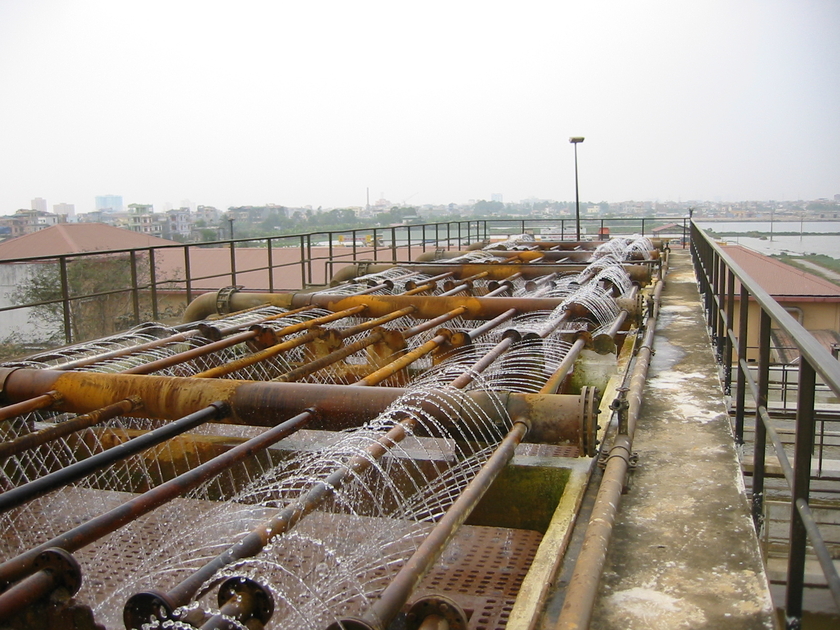
Recent Projects
- AsFePo: Studying in-situ arsenic and phosphate adsorption processes to Fe minerals in groundwater of various redox characteristic
- WAPORICH: Water Quality and Pollution Dynamics in Rivers of the Dry North and Wet South of China
- GAP: Groundwater Assessment Platform
- WRQ: Water Resources Quality
- REMARC : Development of Risk Maps of Arsenic Contamination in Groundwaters of China
- WBL-21: Sustainable water supply of the canton Basel-Landschaft 21
- Reactive Transport modelling of As and other solutes in reducing aquifer environments: Collaboration under the lead of Henning Prommer (CSIRO + UWA, Perth, Western Autralia), and Ilka Wallis (Bundesanstalt für Geowissenschaften und Rohstoffe, Geozentrum Hannover, Germany)
- Groundwater Pollution Red River Delta/Vietnam
Geogenic Contaminants in Ground and Drinking Water in Southeast Asia
Geogenic contaminants in groundwater: Predicting regions at risk
Arsenic contamination of groundwater resources threatens the health of millions of people worldwide, particularly in the densely populated river deltas of Southeast Asia. Maps of areas at risk of groundwater arsenic concentrations have been produced by combining geological and surface-soil parameters in a logistic regression model. They show that Holocene deltaic and organic-rich surface sediments are key indicators for arsenic risk areas and indicate elevated risks in Sumatra and Myanmar where no groundwater studies exist.
Arsenic contaminated groundwater and drinking water in the Red River Delta of northern Vietnam
We have found arsenic concentrations above the Vietnam Standard of 50 ug/L in groundwater samples collected in 1998 in the frame of a heavy metal screening conducted in the Hanoi area of Northern Vietnam.
The Red River delta in Vietnam is one of the most densely populated regions in the world. In 1998 the arsenic problem in Vietnam was identified in the capital city of Hanoi and surrounding rural districts and has since been recognized in other locations of the Red River delta [see Berg et al. 2001 and Winkel et al. 2011]. To identify safe and unsafe areas over the entire Red River delta, a large-scale hydrogeochemical groundwater survey was launched in 2005. It included the analysis of arsenic, manganese, selenium, boron, iron, salinity, phosphate, ammonium, sulfate, dissolved organic carbon, and 30 further chemical parameters. Concentration maps and arsenic risk modeling suggest that several million inhabitants of the Red River delta are at risk of chronic arsenic and/or manganese poisoning.
Arsenic Contamination in the Mekong Delta (Cambodia and Southern Vietnam)
Arsenic contamination of groundwater was also identified in Cambodia, where millions of rural families have installed tube-wells for daily water needs. Initially we conducted a survey comprising 124 groundwater samples in the rural floodplain south of the Cambodian capital Phnom Penh (sampling density ≈1 sample per 30 km2). Besides As, Fe, and Mn, a set of 27 parameters was determined and analysed with respect to redox processes leading to the release of groundwater contaminants. Arsenic concentrations varied from 1–1340 µg L-1 (average 163 µg L-1), with 48% of the tube-wells exceeding 10 µg L-1. Elevated Mn levels are posing an additional health threat to the 1.2 million people living in this area. The occurrence of high As concentrations was found to be sharply restricted to the close vicinity of the Bassac and Mekong River banks and the alluvium braided by these rivers (Kandal Province). Arsenic in this highly affected area averaged at 232 µg L-1 (median 100 µg L-1), while concentrations to the west and east of the rivers were < 10 µg L-1 (WHO guideline drinking value). Arsenic release from Holocene sediments between the Mekong and Bassac Rivers seems to be caused by reductive dissolution of metal oxides, and, to a lesser degree enhanced by pH values ≥ 7. Low groundwater arsenic concentrations are associated with topography featuring gently increasing elevation to the west and east of a shallow valley.
Detailed information on our studies on groundwater and drinking water quality of the Mekong delta and related health risks can be found in our publications.
Transformation of Organic Pollutants in Contaminated Aquifers
Compound-specific Isotope Analysis (CISA) in the assessment of aquifers contaminated by organic pollutants
Compound-specific stable isotope analysis (CSIA) to assess in-situ and ex-situ transformation of organic pollutants in contaminated aquifers
The aim of our research is to develop CSIA in combination with groundwater dating as a tool in the assessment of contaminated field sites. CSIA is capable to
- distinguish on-going pollutant transformation from concentration decrease caused solely by dilution.
- identify transformation mechanism(s). e.g., aerobic/anaerobic, biotic/abiotic, reduction/oxidation.
- determine the extent of in-situ pollutant degradation caused by natural and stimulated attenuation.
- quantify transformation rates (CSIA in combination with groundwater dating techniques).
- allocate (or delineate) sources of contamination.
Isotopes of interest in CSIA: 1H/2H, 12C/13C, 14N/15N, 16O/18O, 35Cl/37Cl
Assessment of Natural and Stimulated Attenuation
Examples
Extent of in-situ PCE degradation and quantification of transformation rates at a contaminated site.
Panel A: Isotopic mass balance (δ13C Σ(CEs)) indicating degrees of PCE dechlorination to ethene.
Panel B: First order degradation rate constants k Σ(CEs) of complete dechlorination using B Σ(CEs).
Reference, Aeppli C., et al. 2009, submitted.
Reference
Aeppli C., et al. 2009, submitted.
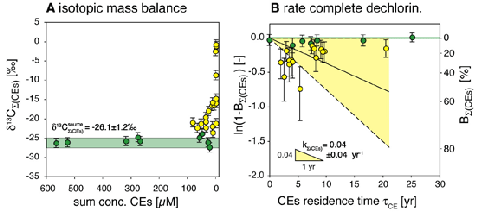
Panel B: First order degradation rate constants k Σ(CEs) of complete dechlorination using B Σ(CEs).
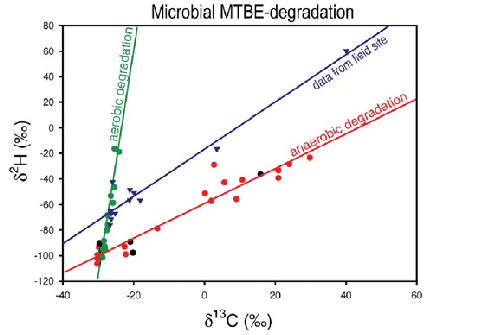
(• red) aerobic biodegradation in a batch experiment;
(• green) anaerobic biodegradation at different field sites;
(• blue) field data from contaminated aquifer.
Reference
Zwank L., et al. 2005. New Evaluation Scheme for Two-Dimensional Isotope Analysis to Decipher Biodegradation Processes: Application to Groundwater Contamination by MTBE. Environ. Sci. Technol. 39, 1018–1029.
C and N isotopic characterization of Nitrobenzene transformation mechanisms.

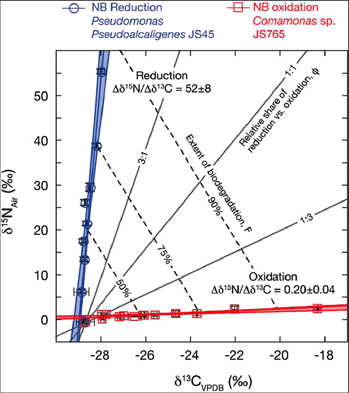
Reference
Hofstetter T.B., et al. 2008. Identifying Competing Aerobic Nitrobenzene Biodegradation Pathways by Compound-Specific Isotope Analysis.
Environ. Sci. Technol. 42, 4764–4770.
H, C and N Isotope Fractionation of Atrazine

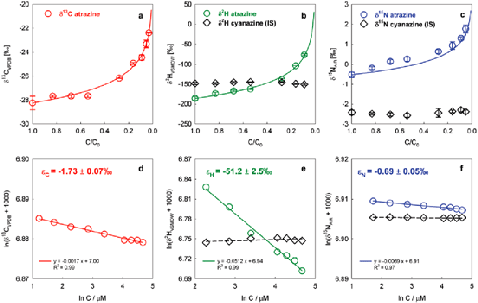
Reference
Hartenbach A.E., et al. 2008. Carbon, Hydrogen, and Nitrogen Isotope Fractionation During Light-Induced Transformations of Atrazine. Environ. Sci. Technol. 42, 7751–7756.
identification of Fe minerals involved in CCl4 degradation.

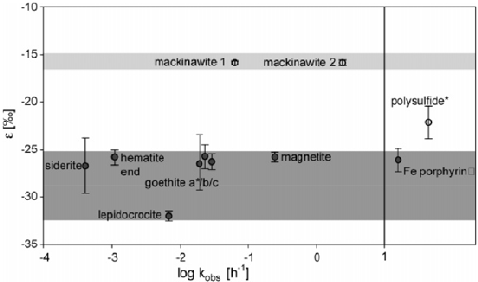
Reference
Zwank L., et al. 2005. Carbon Isotope Fractionation in the Reductive Dehalogenation of Carbon Tetrachloride at Iron (Hydr)Oxide and Iron Sulfide Minerals. Environ. Sci. Technol. 39, 5634–5641.
Staff
Former group members
These People worked in the Contaminant Hydrology Group somewhen since January 2000:
Stefan Haderlein
(Head 1998-2002)
Center for Applied Geoscience (ZAG)
Environmental Mineralogy
Wilhelmstr. 56
D-72074 Tübingen
Torsten Schmidt
(Research Associate 1998-2002)
University Duisburg-Essen
Department of Chemistry
Instrumental Analytical Chemistry
D-47048 Duisburg
Maik Jochmann
(Diploma student)
University Duisburg-Essen
Department of Chemistry
Instrumental Analytical Chemistry
D-47048 Duisburg
Thomas Kellerhals
(Diploma student 2001)
Fatehma Shams
(Diploma student 2001)
Jürg Mühlemann
(Technician 1997-2001)
Samuel Luzi
(Diploma student 2001/2002)
Forschungsstelle für Sicherheitspolitik
Seilergraben 45/47/49
ETH Zentrum
CH-8092 Zürich
Andreas Kappler
(Post Doc, 2000-2002)
Center for Applied Geoscience (ZAG)
Geomicrobiology
Wilhemlstr. 56
D-72074 Tübingen
Thomas Erhart
(Diploma student 2002/2003)
Anna Aeberhard
(Diploma student 2003)
Martin Elsner
(PhD student, 1998-2003)
Helmholtz Zentrum München
Institut für Grundwasseökologie
Ingolstädter Landstrasse 1
D-85764 Neuherberg
Marianne Erbs
(PhD student 1999-2004)
Agroscope FAL Reckenholz
Eidgenössische Forschungsanstalt für Agrarökologie und Landbau
Reckenholzstrasse 191
Postfach, 8046 Zurich
Luc Zwank
(PhD student 2000-2004)
Centre de Ressources des Technologies pour l'Environnement (CRTE)
CRP Henri Tudor
Technoport Schlassgoart
66, rue de Luxembourg
B.P. 144, L-4002 Esch-sur-Alzette
Daniela Fontana
(Diploma student 2004)
EcoRisana SA
Via Cantonale 27
6928 Manno
Irene Hanke
(Diploma student 2004)
Eawag, Abteilung Umweltchemie
Maja Lüssi
(Diploma student 2005/06)
Sylvia Jaus
(Diploma student 2006)
Susanne Schüpbach
(Diploma student 2006)
Nicole Tobler
(PhD student 2003-2007)
RCC Ltd
Zelgliweg 1
4452 Itingen
Huijuan Liu
(Guest Scientist 2007)
Johanna Buschmann
(Postdoctoral Fellow 2006-2008)
University Hospital Zurich
Reconstructive Surgery
8091 Zürich, Switzerland
Akané Hartenbach
(PhD student 2003-2008)
Christoph Aeppli
(PhD student 2004-2008)
Anke Neumann
(PhD student 2004-2008)
Jakov Bolotin
(Technician 2001-2010)
Florian Heeb
(Master Student, 2011)
MyClimate - The Climate Protection Partnership
8002 Zürich, Switzerland
Benoit Pernet-Coudrier
(Post Doc, 2009-2011)
Université de Bretagne Occidentale
Institut Universitaire de Technologie
Génie Biologique
F-29238 Brest, FRANCE
Cristina Jimenez Fernandez
(Guest PhD student, 2010-2011)
Babes-Bolyai University
Faculty of Environmental Science& Engineering
400294 Cluj-Napoca, ROMANIA
Pascal Diefenbacher
(Master Student, 2011)
ETH Zürich + Empa
Safety and Environmental Technology
8600 Dübendorf, Switzerland
Adrian Castrischer
(Bachelor student 2013)
Harald Neidhardt
(Postdoc 2013-2015)
Annick Frising
(Master student 2014)
Marcel Mathis
(Master student 2014)
Bas Vriens
(Postdoc 2015-2016)




